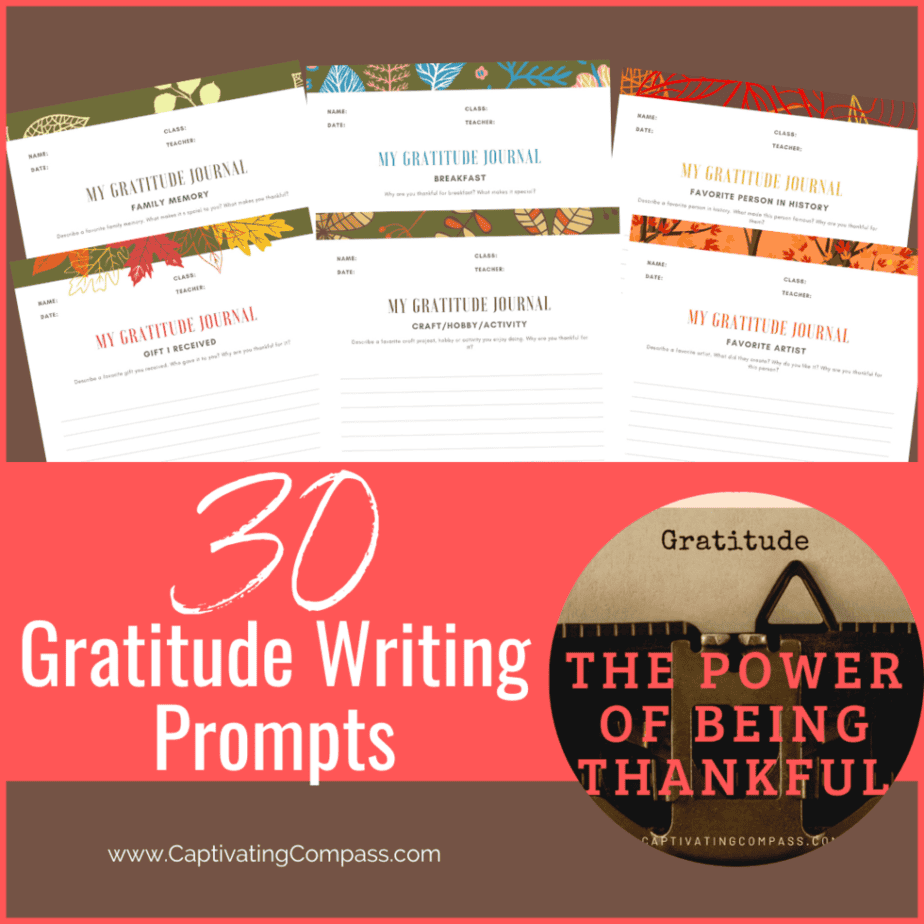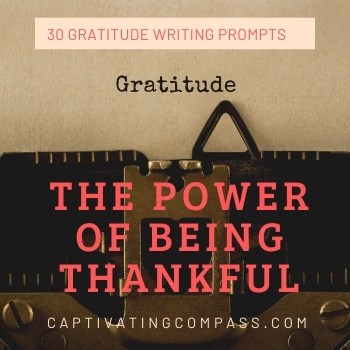Table of Contents
How A Gratitude List Can Completely Flip Your Homeschool Mindset
We are all aware of the importance of practicing gratitude in order to improve our quality of life and increase overall satisfaction with our surroundings. There are various ways to practice gratitude. But committing to it and focusing on ways to find positives in every day can transform your homeschool’s outlook on life. One way to flip your mindset and reap the benefits of gratitude is by creating gratitude lists and incorporating gratitude writing prompts for kids into your daily homeschool routine.
The Importance of Being Grateful
Many studies have proven a direct link between overall happiness, improved mental health, and gratitude. Being grateful allows you to release your comparisons to the lives of others and appreciate what you have. Helping your family learn to do this, will help them learn to find positive things in overwhelming situations as ways to grow. It will also further develop resilience in life – both mentally and emotionally.
When you practice being grateful, you are looking at different situations to find positive outcomes. For example, you may consider these to be overwhelming situations.
- a family move
- the pile of laundry, or even
- school projects/homework
#LIVETHANKFULLY
The goal is to learn to see these as opportunities to express gratitude. Stop stressing about moving or worrying about having a hard time finishing school projects. Instead, learn to find an attitude of gratitude and be grateful for the experiences that have led you to this point. This positive impact is the result of trusting that everything is happening in your favor. The practice of gratitude allows you to look at tough situations with a positive outlook and completely transform your mindset. By creating a habit of gratitude, you (and your kiddos) can learn to #livethankfully.

Grab your Gratitude writing Prompts for Kids at the end of this post
What is a gratitude list?
A gratitude list is an easy way to incorporate gratitude activities into every person’s daily routine. It only takes about five minutes a day, a gratitude journal, and a pen. Here’s what you do:
- You look at your life during your favorite time of day (most do it either at the end of the day or right when you wake up, or both).
- Jot down everything you are grateful for.
Many homeschool families make this a part of their morning routine by drawing pictures, writing thank you cards, or using writing gratitude writing prompts for kids to learn to identify and express ideas of thankfulness.
Need a few examples to explain the concept of gratitude to your kiddos in a simple way? How about these:
- Have young people describe their best day and then ask them what makes them thankful they have had (or can have) that experience.
- Get your teens to pause and express what is great about the present moment. Let them communicate in a way that helps them experience the positive effect of feelings of gratitude for those things that bring the most joy.
- Kids of all ages can improve their writing skills by answering gratitude questions about favorite books, historical time periods, a good friend, or even the hardest thing they did this week.
Catch ’em being Grateful
As a parent, catching your kids being grateful, rather than complaining, is one of those little things that can light up everyone’s day. When you notice your kids being gracious, saying thank you, or acting kind. Let them know how much you appreciate their attitude. Tell them you are grateful that they know how to say nice things to others. Let them know you love how they find good things to have a positive attitude about.
These small acts of modeling gratefulness will produce grateful kids that see the world from a positive perspective. And, when their cup is filled and overflowing with gratitude and joy, they can’t help but share it with others. It’s the small things like saying thanks for cooking a favorite food or setting the dinner table so nicely that show that you believe in your kids and their ability to change the world with kind words, and positive attitudes.
Then when difficult days come, they will have a strong foundation built on gratitude. this helps them create a sense of perseverance and resilience that will help them achieve anything they set their hearts and minds to in life. Now, who doesn’t want that or tier kids?
Back to the list idea…This list can have very simple items such as “I woke up this morning healthy and safe” or “I have received an opportunity that I am excited about”. As a family, (or each person on their own) write down as many items as they can think of during this gratitude journaling exercise because it will trigger moments where you will find examples of gratitude throughout the rest of the day. Over time and with consistency, you will notice your family finding so many different ways to be grateful each and every day.
Benefits of a Thankful Heart

Gratitude allows you to release the stress and anxiety that you may feel that follows you throughout your day. Help your kids and yourself learn to no longer be worried about the possible scenarios that can make the worst day ever or what bad situations will happen next. Rather, teach joy & contentment with what you have and being grateful for your surroundings. By listing out each thing you are grateful for each day, you will inevitably notice yourself feeling overwhelmed with joy and thankfulness throughout your daily life. You’ll have less stress and find that using a daily gratitude journal is quite possibly the best part of your day. Now that’s just a few of the wonderful things every homeschool family member needs!
30 Gratitude Prompts for Kids & More!
So grab these 30 gratitude writing prompts for kids (below) and start learning the power of gratitude in your homeschool. The best way is to keep it fun for the littles who may not be writing yet, by:
- letting them draw pictures,
- create with Lego, or
- simply share their ideas and let someone else do the writing for them.
You’ll find that your young child will enjoy taking this great opportunity to ‘play’. Let them find creative ways to express what it feels like to be a grateful person. Middle school kids gain the benefits of a gratitude journal by listing their favorite things, or a favorite place or favorite movie.
Teens may list their favorite season or favorite songs. The key to this list of ‘things’ is to make sure they are answering the question ‘Why am I grateful for this? Using the topics as conversation starters is a great way to help older kids practice positive habits of gratitude. It is also a great introduction to creative writing or a gratitude challenge.
Creativity and Gratitude Writing Prompts for Kids
No matter the age of your kids, gratitude journal ideas abound everywhere you look. Here’s another quick list:
- favorite character from a book
- favorite holiday
- most enjoyable food
- favorite way to eat chicken
- why their best friend is the best gift ever
- favorite vacation
Remember it’s the simple things in these answers that can be so powerful. Once the ‘Why?’ question is answered, they realize the depth of the great things in their life.
Learning and practicing the art of gratitude is an important life skill. Adding a sense of gratitude into just one aspect of your life will cultivate a sense of joy that is contagious. It is a most beautiful thing to watch grow in your children. These also make great dinner conversation starters or discussion points at bedtime. These are perfect ways to provide opportunities to connect with your kids on a deeper level.
A heritage of gratitude!
Not everything needs to be written down, but the act of capturing the ideas on paper is an excellent way to preserve their growing-up years. Sometimes their ideas of golden and you’ll want to remember them for years to come. In time, your kids will appreciate that you cultivated a heart of gratitude that they will be able to share with their families later in life.
What a beautiful gift for a gratitude journey. So, start them young. Then, let their gratitude journey blossom into a habit that creates a virtuous attitude. This character quality will carry them through the most trying circumstances of life. If we learn to be grateful for the small things in life, we will be able to ‘Give thanks in all things.’ (1 Thes. 5:16) And, learning to be thankful no matter what is what it is all about, right? Enjoy your printable gratitude journal prompts with your kids today! You be glad you did.
Your Gratitude Writing Prompts For Kids & Teens Are Here!
Teaching Teens Gratitude: Your Questions Answered
Gratitude is the appreciation of the good things in life, big or small. It has been shown to have many benefits, including improved mental and physical health, stronger relationships, and a greater sense of well-being.
For teens, gratitude can be especially important as they navigate the challenges of adolescence. It can help them to focus on the positive aspects of their lives, even when things are tough. It can also help them to develop a more positive outlook on life and to become more resilient in the face of adversity.
There are many ways to teach your teen gratitude. Here are a few ideas:
🗝Model gratitude yourself. Teens learn by watching the adults in their lives. Be sure to express gratitude for the good things in your own life, both big and small.
🗝Talk to your teen about gratitude. Explain the importance of gratitude and why it is good for them. You can also talk about your own experiences with gratitude and how it has benefited you.
🗝Create opportunities for your teen to practice gratitude. For example, you can start a family gratitude journal, where everyone writes down one thing they are grateful for each day. You can also have your teen keep a personal gratitude journal or create a gratitude board.
🗝Encourage your teen to give back to others. Helping others is a great way to foster gratitude. Encourage your teen to volunteer their time or donate to a charity that they care about.
Here are a few specific activities that you can do with your teen to promote gratitude:
🗝Gratitude walk. Take a walk with your teen and have them point out things that they are grateful for. This could be anything from the beauty of nature to the kindness of a stranger.
🗝Gratitude jar. Keep a gratitude jar in your home and have everyone write down one thing they are grateful for each day. At the end of the week, read the jar together and discuss all the good things that happened.
🗝Gratitude letters. Encourage your teen to write gratitude letters to the people in their lives whom they are grateful for. This could be their parents, teachers, friends, or anyone else who has made a positive impact on their life.
🗝Gratitude journal. Have your teen keep a gratitude journal where they write down one thing they are grateful for each day. This could be something as simple as a roof over their head or as meaningful as a close friendship.
One way to help your teen sustain a practice of gratitude over time is to make it a regular part of your family routine. For example, you can start each day by having everyone share one thing they are grateful for. You can also end each day by reflecting on the good things that happened.
Another way to help your teen sustain a practice of gratitude is to make it fun and engaging. There are many different ways to do this. For example, you can create a gratitude game or challenge. You can also use creative activities, such as journaling or art, to express gratitude.
The most important thing is to be consistent. Encourage your teen to practice gratitude regularly, even if it is just for a few minutes each day. With time and practice, gratitude will become a natural part of their lives.
Get more prompt ideas for your gratitude journey and thanksgiving lessons for your homeschool and have fun celebrating good gifts!
Holiday Posts you may enjoy
- Wrecked by Thankfulness: Re-Focusing for the Future
- Wrecked by Thankfulness: Promises Kept?
- Wrecked by Thankfulness: Good Gifts
- Wrecked by Thankfulness: Finding Goodness.
- Wrecked By Thankfulness
- Thanksgiving Scavenger Hunt Printable (+Gratitude Challenge)
- inspirational quotes by famous authors: Spring Photo Scavenger Hunt
- Holiday Recipes & Fun Activities For A Healthy And Affordable Holiday Season
- Gratitude Writing Prompts for Kids: The Power of Thankfulness In Your Homeschool
- Easy Cute Christmas Coloring Pages: Kids Printables
- Cyber Week! Black Friday & Cyber Monday Homeschool Mega Sale
- Christmas Traditions in Great Britain | Holiday Unit Study
















